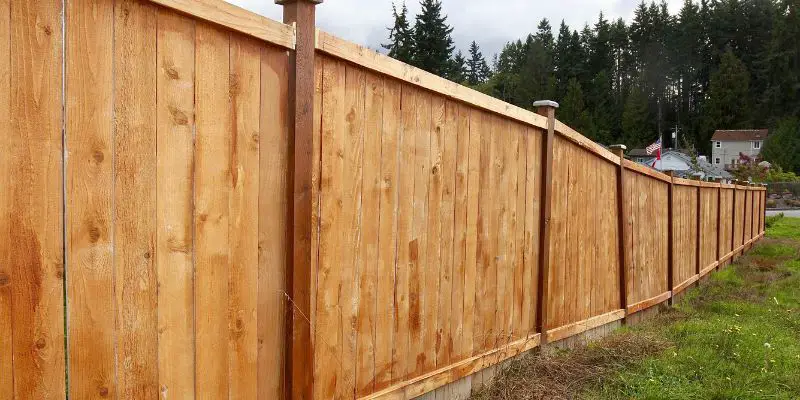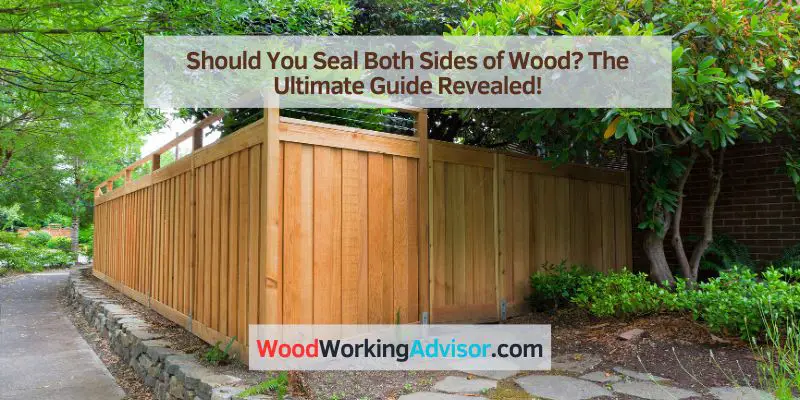Sealing both sides of wood is recommended to prevent moisture absorption and ensure better durability. By sealing both sides of wood, you create a barrier that reduces the chances of the wood warping, cracking, or rotting.
This is particularly important for exterior applications or wood that will be exposed to moisture. Sealing both sides of the wood also helps maintain its dimensional stability, preventing it from expanding or contracting excessively. Additionally, sealing both sides of the wood can enhance the overall appearance by providing a smooth and consistent finish.
It is a proactive measure that prolongs the lifespan of the wood and protects it from environmental factors. Overall, sealing both sides of wood improves its longevity and performance.
Why Seal Wood?
Sealing both sides of wood is essential to prevent moisture damage, warping, and decay. By applying a protective sealant, you can prolong the lifespan of the wood and maintain its appearance. Proper sealing enhances durability and protects against environmental factors, making it a crucial step in wood preservation.
Wood, with its timeless beauty and versatility, is a popular option for furniture, flooring, and various other applications. However, to maintain its appeal and extend its lifespan, it is crucial to protect it from the elements. This is where sealing comes into play. By applying a sealant to the wood surface, you create a protective barrier that shields it from moisture, prevents warping and splitting, and enhances its overall durability. In this article, we will delve deeper into the reasons why you should seal wood to ensure its long-lasting beauty and functionality.

Protection From Moisture
Moisture is one of the primary enemies of wood. When wood absorbs moisture, it can lead to swelling, warping, and rotting. This can compromise its structural integrity, causing damage that is often irreversible. By sealing both sides of the wood, you create a waterproof barrier that prevents moisture penetration. The sealant acts as a shield, repelling water and preventing it from seeping into the wood fibers. Whether you are using wood indoors or outdoors, protecting it from moisture is crucial to maintaining its appearance and structural stability.
Prevention Of Warping And Splitting
Warping and splitting are common issues that occur when wood is exposed to moisture or humidity imbalances. When wood absorbs moisture unevenly, it can cause the fibers to expand and contract at different rates. This leads to warping, where the wood bends or twists out of its original shape. Additionally, when the wood dries out too quickly, it can result in splitting or cracking. By sealing both sides of the wood, you minimize its interaction with moisture, reducing the likelihood of warping and splitting. This ensures that your wood retains its original form and structural stability, prolonging its lifespan.
Enhanced Durability
Wood is a natural material that can be susceptible to wear and tear over time. However, sealing the wood enhances its durability and extends its lifespan. The sealant creates a protective layer that shields the wood from physical damage, such as scratches, stains, and impacts. Additionally, sealing helps to preserve the wood’s natural color, preventing it from fading or discoloration caused by exposure to sunlight. By enhancing the wood’s durability, sealing allows you to enjoy its beauty and functionality for years to come.
In conclusion, sealing both sides of wood is essential for its protection, prevention of warping and splitting, and enhanced durability. By creating a barrier against moisture, you safeguard the wood from potential damage and ensure its long-lasting beauty and functionality. Whether you are working with furniture, flooring, or any other wooden project, taking the time to seal the wood will undoubtedly pay off in the long run. So, make sure to invest in a quality sealant and give your wood the protection it deserves.
Sealing Both Sides: Pros And Cons
When it comes to preserving and protecting your wood projects, one common question that arises is whether you should seal both sides of the wood. While there are advantages and disadvantages to sealing both sides, it’s important to understand the implications before making a decision. In this section, we will explore the pros and cons of sealing both sides of wood.
Advantages Of Sealing Both Sides
Sealing both sides of the wood offers several benefits that can enhance the durability and longevity of your projects.
- Improved moisture resistance: When you seal both sides of the wood, you create a barrier that prevents moisture from penetrating the wood fibers. This helps to minimize swelling, warping, and rotting, particularly in areas with high humidity or exposure to moisture.
- Uniform protection: By sealing both sides, you ensure that the entire piece of wood is protected, reducing the risk of uneven weathering or deterioration. This can be especially important for outdoor projects that are exposed to harsh elements like sunlight and rain.
- Enhanced aesthetics: Sealing both sides can result in a more attractive finish by providing a consistent appearance. It can help to even out the absorption and distribution of stains, paints, or varnishes, resulting in a more uniform and professional-looking surface.
Disadvantages Of Sealing Both Sides
While sealing both sides of wood has its advantages, there are also some potential drawbacks that should be considered.
- Inhibits natural movement: Wood is a natural material that expands and contracts with changes in humidity. By sealing both sides of the wood, you limit its ability to breathe and adjust to environmental conditions. This can lead to increased stress on the wood structure, potentially causing cracks or warping over time.
- Increased preparation and cost: Sealing both sides of wood requires more effort, time, and materials compared to sealing just one side. This can add to the overall cost and complexity of your project, particularly if you are working with a large quantity of wood or have multiple surfaces to seal.
- Reduced breathability: If the wood is intended for outdoor applications, sealing both sides can reduce its ability to release moisture, resulting in potential moisture buildup and trapping. This can contribute to a higher risk of mold or fungal growth, particularly in humid climates.
Considering these pros and cons, it is evident that sealing both sides of wood can provide significant benefits in terms of moisture resistance, protection, and aesthetics. However, it’s important to weigh these advantages against the potential drawbacks, such as inhibiting natural movement and increased preparation and cost. Ultimately, the decision to seal both sides of the wood depends on the specific project, its intended use, and the desired level of protection and preservation.
When To Seal Both Sides
Sealing wood is a crucial step to enhance its durability and protect it from moisture damage. However, there are situations where sealing only one side may not be enough. In this section, we will explore three specific scenarios where sealing both sides of wood is highly recommended.
Outdoor Applications
If you are using wood for outdoor applications, such as decks, fences, or furniture, it is essential to seal both sides. Outdoor wood is constantly exposed to harsh weather conditions, including rain, UV rays, and temperature changes. These elements can lead to significant moisture absorption and subsequent damage if not protected adequately.
By sealing both sides of outdoor wood, you create a protective barrier that helps prevent moisture penetration from all directions. This ensures an extended lifespan for your wood and minimizes the chances of warping, rot, or decay caused by prolonged exposure to outdoor elements.
High Humidity Environments
High humidity environments, such as bathrooms, kitchens, and basements, can significantly impact the moisture content of wood. In these areas, the moisture in the air can seep into the wood, causing it to expand, warp, or even promote mold and mildew growth.
Sealing both sides of wood used in high humidity environments is necessary to create a moisture barrier on all surfaces. This protective layer helps prevent excessive moisture absorption, maintains the wood’s structural integrity, and reduces the risk of damage caused by humidity-related issues.

Wood With Uneven Moisture Content
Wood with uneven moisture content can pose a challenge when it comes to sealing. If only one side of the wood is sealed, it can lead to an imbalance in moisture absorption and release, causing the wood to warp or bow over time.
By sealing both sides of wood with uneven moisture content, you create a uniform environment where moisture can be regulated evenly. This helps reduce the risk of uneven swelling or shrinking, ensuring the stability and longevity of the wood.
Frequently Asked Questions On Should You Seal Both Sides Of Wood
Do You Need To Varnish Both Sides Of Wood?
Yes, it is important to varnish both sides of wood. Varnishing both sides helps to protect the wood from moisture damage and warping. It also helps to create a more uniform appearance and finish.
Do I Need To Finish Both Sides Of Butcher Block?
Yes, it is recommended to finish both sides of a butcher block. Finishing helps protect the wood from moisture and prolongs its lifespan. It also enhances the appearance and makes it easier to clean.
Do You Seal The Underside Of A Table?
Yes, it is recommended to seal the underside of a table. Sealing helps protect the wood from moisture, warping, and damage. It also improves the overall durability and longevity of the table.
Should I Finish Both Sides Of A Table Top?
Yes, it is recommended to finish both sides of a tabletop. This ensures that the table is protected from moisture, heat, and other potential damage. It also provides a uniform appearance and enhances the durability of the table.
Conclusion
Sealing both sides of wood is a wise practice to prolong its lifespan and protect it from common issues like warping and moisture damage. By creating a barrier on both surfaces, you ensure a complete defense against external elements. Additionally, this process enhances the overall appearance of the wood and maintains its structural integrity.
So, remember to seal both sides of wood for optimal durability and beauty.


